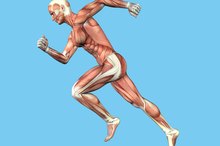What Are Protein Polymers?
Protein is a general term used to described hundreds of thousands of substances made from building blocks called amino acids. Amino acids form proteins by linking to each other through connections called peptide bonds. Scientists use the term polymerization to refer to the formation of peptide chains and, as the end result of this process, proteins are technically defined as polymers of amino acids.
Basics
Virtually all proteins come from a combination of just 20 different amino acid molecules. In turn, each of these acids is formed by a central atom of carbon connected to an atom of hydrogen, as well as a group of atoms called a carboxyl group and another group of atoms called an amino group. The thing that distinguishes amino acids from each other is an additional element called a side chain; depending on the types of atoms in its side chain, any given amino acid has different chemical characteristics, or properties.
Polymerization
What Are the Functions of Peptides?
Learn More
In each other’s presence, the different types of amino acid molecules undergo chemical reactions that make them bond together and form larger molecules. Scientists refer to molecules that go through these accumulating reactions as monomers. Since they come from chains of monomers, proteins are also known as polymers. To qualify as proteins, amino acid chains must contain more than about 30 individual acids. If roughly 30 or fewer amino acids bond together, the resulting chains are typically referred to as peptides.
- In each other’s presence, the different types of amino acid molecules undergo chemical reactions that make them bond together and form larger molecules.
Protein Polymer Uses
The human body contains about 100,000 different protein polymers, or proteins. When you eat foods that contain protein from animals or plants, your body breaks their protein content down into individual amino acids, then uses these acids to form polymers that fit human nutritional requirements. Specific uses of human protein polymers include transportation of oxygen in your bloodstream, carbohydrate digestion and formation of structures such as your muscles, skin, tendons and hair.
Considerations
What Is Synthetic Protein?
Learn More
Because they contain materials joined together by multiple peptide bonds, proteins are also sometimes referred to as polypeptides. In addition to proteins, your body uses the polymerization process to create the nucleic acids that form your DNA. Scientists in the field of study called biotechnology use polymerization in laboratory settings to reform proteins for specific medical and industrial purposes. They also apply the principles of polymerization to make synthetic, nonprotein materials that include:
- nylon
- polystyrene
- neoprene
- Bakelite
- polyvinyl chloride
- or PVC
Plants use polymerization to form substances that include amber, cellulose and shellac.
- Because they contain materials joined together by multiple peptide bonds, proteins are also sometimes referred to as polypeptides.
- They also apply the principles of polymerization to make synthetic, nonprotein materials that include: * nylon
* polystyrene
* neoprene
* Bakelite
* polyvinyl chloride
* or PVC Plants use polymerization to form substances that include amber, cellulose and shellac.
Related Articles
References
- Biology Online: Monomer
- Biology Online: Polymer
- The National Academies of Sciences, Engineering and Medicine, Health and Medicine Division. "Dietary Reference Intakes Tables and Application."
- United States Department of Agriculture Agricultural Research Service. National Nutrient Database for Standard Reference Release 28.
- Gropper SS, Smith JL, Groff JL. "Advanced Nutrition and Human Metabolism." Sixth Edition. Belmont, CA. Wadsworth Publishing Company, 2013.
- Smolin LA, Grosvenor, MB. "Nutrition: Science and Applications." Third Edition. Wiley Publishing Company, 2013.
Writer Bio
M. Gideon Hoyle is a writer living outside of Houston. Previously, he produced brochures and a wide variety of other materials for a nonprofit educational foundation. He now specializes in topics related to health, exercise and nutrition, publishing for various websites.








